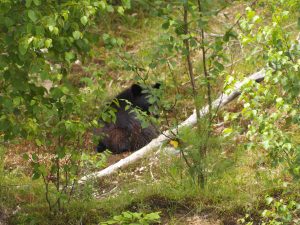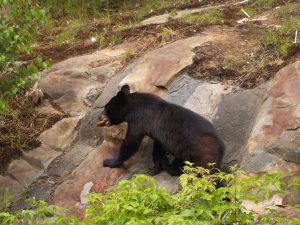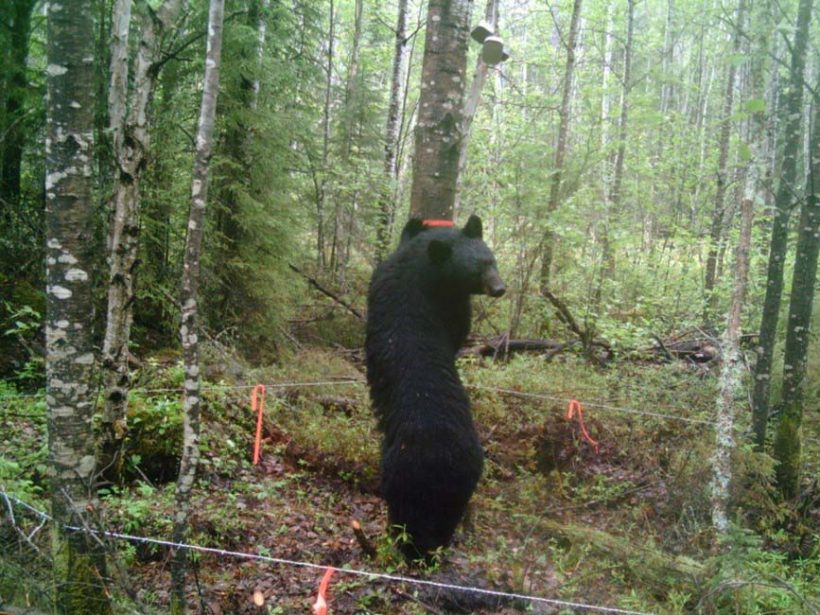THE BEAR CENSUS
Once upon a time I reported that in North Hastings there was one bear per square km – or words to that effect. A quick reader responded that he’d like to sign them up on his electorate list and run for office. Presumeably the Bear Party. Not only did I miss that gaff but ditto for the editor.
Wildlife of course does not sign up for a population census. And since the spring bear hunt has been revitalized – even as a pilot project – the MNRF wants to get a more accurate handle on just how many bruins are wandering around “out there.” Enter the Barbed Wire Hair Trap (BWHT). (See the MNRF photo.)
Bear hunters are obliged to submit a report no matter the outcome plus some dental evidence that helps presently to ID the animal’s age. (New regulations in 2019 will require all hunting participants to submit reports.) Combined with evidence from the BWHT this should provide a more accurate bear count. It is important to monitor bear populations for sustainability as bears are slow to sexually mature and reproduce thus they erbound slowly if harvest numbers are too high.

The Bear Hair Traps are set during the spring when bears tend to occupy fixed ranges and remain in that habitat. Studies from the Bruce Peninsula and Chapleau indicate that bears begin to disperse as early as the first week in July. This sampling study lasts 6 weeks – May to June – and is not impacted significantly by the spring bear hunt and it avoids Bear Management Areas (BMAs) as much as possible. Each trap is checked for hair once a week on the same day of each week. During the first few weeks researchers expect to see the most new animals.
Pre-planning and carrying out the plans require a lot of time, energy and resources as each trapline – which is a minimum of 30 km “as the crow flies” – hosts 40 trap stations that are spaced 1.5 km apart. It can take upwards of one hour to find the perfect “station” location that is 30 m from the main trap line trail which avoids water, swamps, habitat unfriendly to bears and, of course, dumps.
Flagging tape is used to identify these enclosures that consist of double stranded barb wire 50 cm from ground level. This is meant to avoid capturing cub hair. The 50 cm is “just right” for capturing adult hair. “We exclude cubs and sub adults because the statistical analysis used depends on the independence of black bears.” (MNRF) The design of the enclosure is meant to ensure that bears enter and exit the trap via different routes. Each week a new can of the same flavoured sardines is opened as an attractant whether the station had received a visitor or not.
The data collected will be used to extrapolate bears numbers and could influence BMAs regarding tags available for both resident and non-resident hunters.
Locations for such BWHTs vary year to year. Bancroft District did not have a line in 2017 but had two lines in 2018. The line in Wildlife Management Unit (WMU) 55a provided 141 hair samples; WMU 54 provided 259 samples. Bear in mind the “3 hair rule.” Each sample must include a minimum of 3 hairs for DNA testing purposes at the Trent University DNA Lab. Significantly, the number of hair samples do not directly correlate to population densities.

Steven Sucharzewski, MNRF Fish & Wildlife Technical Specialist, said that the ministry has just completed its second year of a four year study. There were a total of 27 lines throughout the province; 9 in southern Ontario. In 2017, the MNRF collected 14,000 hair samples; in 2018, 21,000 samples – “considered a very good sample”. The lines are dismantled following the 6-week study.
It will be roughly 2021 before the study details will be released. “There is no predicted date for a final study result. We cannot predict the amount of samples collected year to year – which can greatly influence the time involved in processing and extrapolating data.” (Sucharzewski)
The next time you are in the bush, if you happen to come upon such a set-up, you will now know what you are seeing.
